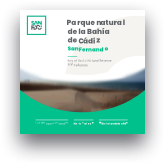Bahía de Cádiz Natural Park is one of the main wetlands of southern Europe, forming part of the Andalusia Network of Protected Natural Areas. With its 26,000 plus acres, it is one of the most unique of its kinds for the diversity of its ecosystem that includes a true labyrinth of dunes, tributaries, marshes and beaches.

Our 5-star beach covers 3 miles of the Atlantic Ocean. It is a virgin beach integrated into Bahía de Cádiz Natural Park, in an unparallel frame; a true natural paradise. The quality of its waters and its extremely fine golden sand have made it worthy of the Blue Flag of Clean Beaches of Europe and it has certified excellence with the Q for Tourism Quality.
Here you can enjoy a pleasant family environment and find, if you prefer, quiet separate spaces where the breeze and the sea are your only company.
This Visitors Centre is next to Camposoto Beach and is the ideal starting point to discover Bahía de Cádiz Natural Park, since it is close to several trails. Inside you can enjoy the permanent exhibition “A History of Water and Sludge” which, with amazing models and colourful panels, tells you about the values of this unique natural space. From the centre’s viewpoint, you can watch birds in their natural environment. If you want to get to know Cádiz Bay Natural Park, be sure to visit.
Through the marshes, a series of trails have been designed to take you through areas of extraordinary scenic beauty: River Arillo Trail, Punta del Boquerón and El Carrascón Trail. Of particular significance is bird watching, the changing colour of its waters and the wise layout of the estuaries which enables their heating and pre-evaporation that ends in the salt pits.
For many years, to talk about San Fernando was to talk about salt. The salt marshes have been the protagonists of the natural landscape of their natural environment and today constitute one of the main resources for the conservation of numerous species of water birds. They are characterised by a series of ponds of different depths, excavated in the marsh and connected by a network of tributaries and canals through which the tides enter. The salt marshes have been and are the symbol of a way of life, although there are currently only two, which are the salt marshes dedicated to salt production in San Fernando.
These kinds of constructions, or their ruins, are likely to go unnoticed during a walk through our natural environment. You might think they were small hamlets built on a whim in such specific places, but nothing could be further from the truth. Certainly, a long time before human understanding managed to comprehend the reasons why, twice a day, in a rhythmic and periodical manner, the sea water level rises and then falls, people learned to take advantage of this cyclical fluctuation of the water as a motor force that moved mills built to mill the grain: tide mills. They were undoubtedly experts in the area’s industrial activity and technological exponents in the 17th and 18th centuries.
The Botanical Garden was born with the aim of conserving the Andalusian plant species that are threatened with extinction, having among its tasks that of showing visitors the plant wealth of the province of Cádiz. It also has a collection of ornamental plants commonly used in the parks and gardens of our towns and cities.